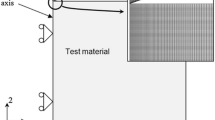Abstract
Representative strain plays an important role in indentation analysis; by using the representative strain and stress, the normalized indentation load becomes a function of one variable, which facilitates the reverse analysis of obtaining the material plastic properties. The accuracy of such function is critical to indentation analysis. Traditionally, polynomial functions are used to fit the function, which does not incorporate correct elastic/plastic limits and has no physical basis. In this paper, we have proposed a new limit analysis-based functional formulation based on the theoretical solutions of conical/wedge indentation on elastic and rigid plastic solids. It is found that both limits agree well with numerical results, and the new approach involves no—or at most one—fitting parameter, which can be obtained with much less effort compare with the traditional polynomial approach. Reverse analyses on five different materials have shown that the new and simple limit analysis-based formulation works better than the traditional polynomial fit. The new technique may be used to quickly and effectively measure material plastic properties for any conical indenter if the elastic modulus is known a priori.
Similar content being viewed by others
Change history
03 March 2011
An Erratum to this paper has been published: https://doi.org/10.1557/jmr.2006.0319
References
Y.T. Cheng, C.M. Cheng: Absence of one-to-one correspondence between elastoplastic properties and sharp-indentation load-penetration data. J. Mater. Res. 20, 432 (2005).
Y.T. Cheng, C.M. Cheng: Scaling, dimensional analysis, and indentation measurements. Mater. Sci. Eng. R44, 91 (2004).
K.L. Johnson: Contact Mechanics (Cambridge University Press, Cambridge, UK, 1985).
S.D. Mesarovic, N.A. Fleck: Spherical indentation of elastic-plastic solids. Proc. Roy. Soc. London A455, 2707 (1999).
M. Dao, N. Chollacoop, K.J. VanVliet, T.A. Venkatesh, S. Suresh: Computational modeling of the forward and reverse problems in instrumented sharp indentation. Acta Mater. 49, 3899 (2001).
J.L. Bucaille, S. Stauss, E. Felder, J. Michler: Determination of plastic properties of metals by instrumented indentation using differnt sharp indenters. Acta Mater. 51, 1663 (2003).
N. Chollacoop, M. Dao, S. Suresh: Depth-sensing instrumented indentation with dual sharp indenters. Acta Mater. 51, 3713 (2003).
N. Ogasawara, W. Makiguchi, N. Chiba: Plastic Properties determination method for power-law hardening material using plural triangular pyramid indenters. Trans. Jpn. Soc. Mech. Eng. 70, 1529 (2004).
M. Zhao, N. Ogasawara, N. Chiba, X. Chen: A new approach of measuring the elastic-plastic properties of bulk materials with spherical indentation. Acta Mater. 54, 23 (2005).
Y.P. Cao, J. Lu: A new method to extract the plastic properties of metal materials from an instrumented spherical indentation loading curve. Acta Mater. 52, 4023 (2004).
J. Alkorta, J.M. Martinez-Esnaola, J. Sevillano Gil: Absence of one-to-one correspondence between elastoplastic properties and sharp-indentation load-penetration data. J. Mater. Res. 20, 432 (2005).
N. Ogasawara, N. Chiba, X. Chen: Representative strain in indentation analysis. J. Mater. Res. 20, 2225 (2005).
L. Wang, S.I. Rokhlin: Universal scaling functions for continuous stiffness nanoindentation with sharp indenters. Int. J. Solids Struct. 42, 3807 (2005).
ANSYS 2003, Ansys Release 8.0 Documentation (ANSYS Inc., Canonsburg, PA).
I.N. Sneddon: The relationship between load and penetration in the axisymmetric Boussinesq problem for a punch of arbitrary profile. Int. J. Eng. Sci. 3, 47 (1965).
J.C. Hay, A. Bolshakov, G.M. Pharr: A critical examination of the fundamental relations used in the analysis of nanoindentation data. J. Mater. Res. 14, 2296 (1999).
F.J. Lockett: Indentation of a rigid/plastic material by a conical indenter. J. Mech. Phys. Solids 11, 345 (1963).
D.S. Dugdale: Wedge indentation experiments with cold-worked metals. J. Mech. Phys. Solids 2, 14 (1953).
N. Ogasawara, W. Makiguchi, N. Chiba: Plastic properties determination method using triangular pyramid indenters based on elastic solution and ridgid/perfectly plastic solution. Trans. Jpn. Soc. Mech. Eng. 71, 1406 (2005).
L. Wang, M. Ganor, S.I. Rokhlin: Inverse scaling function in nanoindentation with sharp indenters: Determination of material properties. J. Mater. Res. 20, 987 (2005).
Author information
Authors and Affiliations
Corresponding author
Rights and permissions
About this article
Cite this article
Ogasawara, N., Chiba, N. & Chen, X. Limit analysis-based approach to determine the material plastic properties with conical indentation. Journal of Materials Research 21, 947–957 (2006). https://doi.org/10.1557/jmr.2006.0108
Received:
Accepted:
Published:
Issue Date:
DOI: https://doi.org/10.1557/jmr.2006.0108




